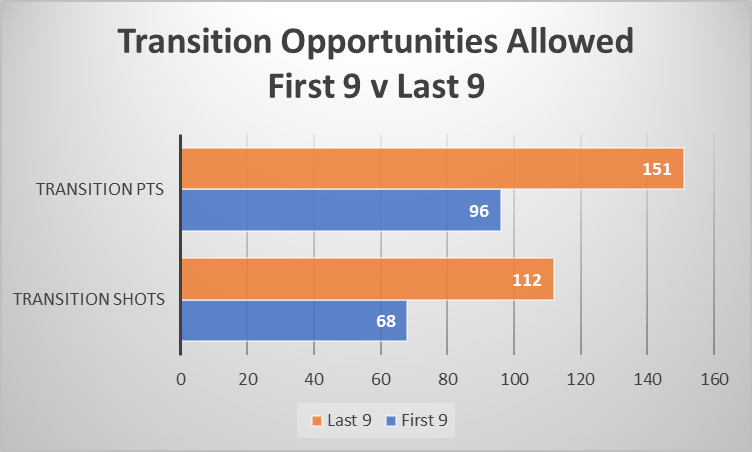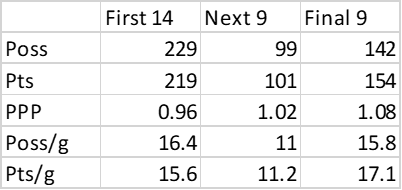Following a thorough late night victory over Villanova on Feb 2, the 2nd win over the Big East’s standard bearer in 2 weeks, Marquette was sitting at 16-7, 8-4 in Big East play and dreaming of just high the ceiling for this team could be.
It wasn’t just that it beat Nova twice, it was a culmination of a 9-game stretch that spanned a month and had Marquette playing as one of the best team’s in the country. That wasn’t a fanboy’s opinion either. Look at this clip from Feb 4th, with 3 national pundits, none with any affiliation to Marquette each proclaiming that this squad was the Big East’s best bet to make a Final Four.
And if you don’t put much stock in late night pods, the cold hard math said similar things. If you filtered team performance on Bart Torvik’s site from Jan 2 to Feb 4th, Marquette was playing as the 3rd best team in the country behind only Gonzaga and Kentucky.

Apologies for any PTSD, but the question all of us, even Shaka himself, have been asking over the last 2 month:s What the heck happened the rest of the way?
As with anything in basketball, there is no magic bullet that when uncovered, will reveal all the correct answers. A few things combined to impact Marquette negatively and they are borne out in the stats we’ll dive into. But even this is not a full accounting of what transpired. I have no insight into the locker room, the team chemistry, the coaches’ worries, or the player’s though processes. So take this all with as many grains of salt as are needed.
Here is our first installment in the series.
Transition Defense
I think this is a good place to start because it was literally the first change we saw the game immediately following the 2nd Nova win.
Riding high and looking to avenge an earlier loss to UConn, Marquette put up one of the worst defensive halves (to that point) against the Huskies, down by 14 just 15 minutes into the game and giving up 46 points in the first 20 minutes. Here is my analysis of the issue the morning after.
And although I ended it saying it can’t happen again, it would in fact happen with unnerving frequency. This game opened a blueprint that opposing teams would use to punish Marquette over and over and over again the rest of the way. If you got a rebound, push it. If you forced a turnover, push it. If they scored on you, no worries push it some more. Of the Huskie’s 19 transition opportunities that game, only 2 came after Marquette turnovers.
Again, though, this wasn’t a one-game anomaly. Diving into Synergy data, the difference between the glorious 9 game stretch and the infamous one couldn’t be more stark.

In the final 9-games, Marquette gave up 4.9 additional transition shots per game, compared to the 9 games prior. That resulted in 55 additional points, or 6.1 per game.
I can’t reiterate just how enormous the gulf is. Usually when we dive into numbers at this granular level, we’re only talking about a 1 or 2 possession difference per game. To have such a contrast in the same number of games against the same quality of teams (all Big East + UNC), shows that this was a fairly extreme change.
Now, having re-watched about half of the transition opportunities once more, I reach my limit as to identifying the cause of the issue. Some of it is more misses on the offensive end (particularly from 3s) leading to run outs, but to my untrained eye, it looked like opponents making it a priority to push the ball, and Marquette not communicating particularly well while scrambling.
How good have Shaka’s teams been historically in transition D?
Of course, this is the point where I like to put relatively small samples into a larger context. Shaka Smart has been one of the most consistent defensive coaching minds in the game for over a decade. Over the previous 10 seasons before making his way to Milwaukee, Smart had every single one of those teams finish in the top-40 of the Ken Pom Adjusted Defensive rankings. There is no questioning his ability to build a top-of-the line defense.
Comparing the 2022 results to the rest of his tenure, this squad gave up the most transition opportunities since 2015 at VCU and had the 3rd worst efficiency in Shaka’s tenure, giving up 1.009 PPP in transition.

All of this is to say, this squad wasn’t as “all out” as those VCU havoc teams, but did give up more opportunities than at any point in time while in Austin. Lots of opportunities, and poor efficiency is a recipe for underperformance.
What was the outlier?
Focusing back on this season, if we break it out into thirds, the outlier isn’t the final 9 games, but rather the fantastic 9. In the first 14 games to start the season, MU gave up 16.4 possessions a game and 156 pts. (Note, this table below is using all possessions, not just shots, so the numbers will vary slightly from our initial graph.)

But this is where the numbers don’t tell you everything. At the start of the year, MU pressed much more often, resulting in more transition turnovers. The 0.956 PPP allowed would rank 102nd in the country in 2022. So not amazing, but certainly not terrible.
What happened was as Marquette’s half court defense improved, Shaka pressed with much less frequency giving up fewer quick buckets, but also creating fewer quick turnovers. This was a tradeoff that worked brilliantly in those fantastic 9 games. A 1.02 PPP isn’t great, but because there were only 11 possessions allowed on average, the overall impact was mitigated.
However, post the 2nd UConn game, Marquette’s efficiency plummeted to go along with a significant increase in quantity, as we detailed near the top. So even though we saw high numbers of transition possessions from opponents before, the reason the defense seemed so much worse late was that the transition wasn’t being forced by a pressure defense, but rather Marquette simply not being able to stop teams from pushing the pace.
All of this culminated in one of the most embarrassing postseason performances in Marquette history, where North Carolina scored 30 points on 21 transition possessions, an unfathomable 1.43 PPP.
If you are looking to understand what went wrong for Marquette down the stretch, the first place to look is the transition defense.

Leave a comment